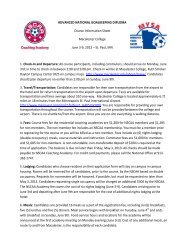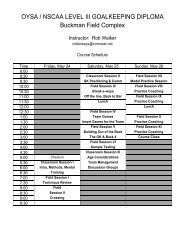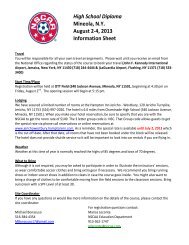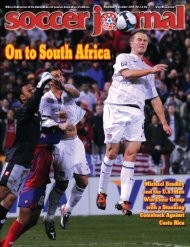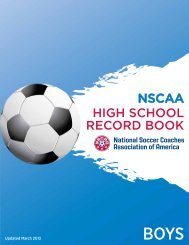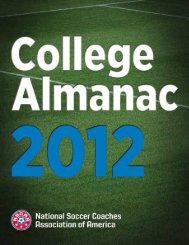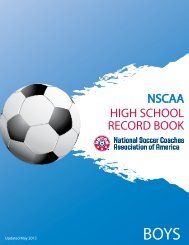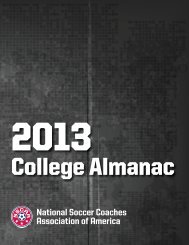Advanced National Goalkeeping Diploma - National Soccer ...
Advanced National Goalkeeping Diploma - National Soccer ...
Advanced National Goalkeeping Diploma - National Soccer ...
Create successful ePaper yourself
Turn your PDF publications into a flip-book with our unique Google optimized e-Paper software.
<strong>Advanced</strong> <strong>National</strong> <strong>Goalkeeping</strong> <strong>Diploma</strong>• Two-handed parrying: Typically used when the ball has too much pace for the keeper to catch but is notnecessarily at full stretch. In such cases parrying via two hands ensures a solid surface.• When parrying, the hand and fingers are an extension of the arm and remain as stiff as possible to allow for asolid surface for parrying ultimately moving through the ball at the time of the save. Safely parrying the ballwide is essential and should be stressed, but ultimately the ball must stay in front of the GK.5. Back-to-the-Bar• The timing and preference of using one or two hands in parrying lay in the trajectory of the ball in relation tothe body position of the keeper and the distance from the goal.• The 2-handed parry should be used when the keeper is square to the shooter and the ball played directlyoverhead and little footwork is required to make the save.• The 1-handed parry should be advocated when the ball is slightly to either side of the keeper, or the keeper isforced to retreat to his line to make the save.• The 2-handed parry is accompanied with a two-footed jump from the set position, the hips and shouldersremaining square to the field/shooter. Hands (open-handed and fingers extended) move together directlyoverhead to meet the ball and push it over the bar.• The 1-handed parry is typically accompanied by sideways footwork leading to a one-footed jump, the handclosest to the field/shooter ideally being used to parry the ball;• If the ball has dropped beyond and lower than the top hand, the bottom hand must be used. The hand usedshould remain open and fingers extended. The wrist should remain solid, the hand serving as an extension ofthe arm.DistributionBowlingUsed for relatively short distribution. The ball is drawn backwards behind the body as the GK steps forward intoa lunge position with the leg opposite the distributing arm. Moving the ball forward the keeper releases the balldirectly on the ground in order to ensure a user friendly pass, and follows through with the arm and moves tosupport his pass.Baseball ThrowUsed for mid-length distribution. The keeper draws the ball back even with the ear, simultaneously lowering thebody into a lunge position with the leg opposite the distributing arm. The keeper begins forward motion of theball via the elbow and shoulder to throw the ball at such a distance that the ball reaches the targeted player’sfeet with pace but rolling cleanly on the ground.Sling ThrowUsed for longer distribution. The GK begins in a sideways position relative to the targeted player, with the nondistributinghand pointing towards the player and the distributing hand drawn back in the opposite direction.The keeper brings the ball directly over the top of the body with the trunk turning simultaneously to assist inthrowing power. Following through the distributing arm continues to lead, the trunk following and the hipsturning forward and the rear leg coming forward.Note: Power may be increased by using the body’s momentum as the keeper begins the throwing movement.Smaller keepers are going to need to utilize both hands to control the ball in the backwards movement prior tobeginning the throwing portion.98 Appendix A – Additional Topics




